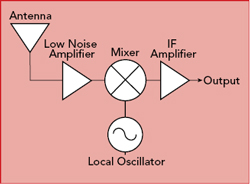
Modern system requirements placed on a microwave receiver design are often difficult to achieve, because small size, low-cost and high performance are often at odds. First and foremost, any new design will typically need to offer a performance advantage over existing systems. For example, in a superheterodyne system (see Figure 1), an engineer may be asked to design for wider bandwidth, lower system noise figure and higher linearity. Often, the limiting component for all of these specs is the low noise amplifier (LNA) immediately following the antenna.

Figure 1 Simplified block diagram of a superheterodyne receiver.
When deciding how to implement the LNA, a designer has several options. Typically, the best performing solutions are hand-tuned amplifiers, which require considerable board space and are both costly and time consuming to manufacture. MMIC LNAs, on the other hand, offer the smallest size and easiest manufacturing solution. A compromise between these two is a design using discrete transistors, but without hand tuning. This approach is relatively easy to manufacture, yet still requires large board area.
Obviously, if performance were the only metric, a hand-tuned discrete solution would be used in most applications. This is rarely the case, however, and the need to reduce size, weight, power and cost (SWaP-C) requires the designer to consider the other two options. The final consideration is often which is more important: meeting a difficult size requirement or having the best possible noise figure.
ULTRA-LOW NOISE AMPLIFIERS MEET BOTH
Custom MMIC now offers a MMIC solution that solves both challenges. The CMD283C3 is the first in what will be a series of ultra-low noise amplifiers. This off-the-shelf packaged MMIC features performance previously achievable only with discrete solutions. Operating from 2 to 6 GHz, the LNA has a typical noise figure of 0.6 dB with greater than 20 dB gain across the band (see Figure 2).

Figure 2 Typical gain and noise figure of the CMD283C3.

Figure 3 Evaluation board shows the small size of the LNA, with few external components.
Fabricated with an enhancement mode PHEMT process, the CMD283C3 has many features in addition to the world-class noise figure, making it an ideal solution in a receiver front-end. One key benefit is the all positive bias, which means no negative power supplies or sequencing voltages. The CMD283C3 is self-biased and provides input and output DC blocking capacitors on-chip. Eliminating the external components needed with a depletion mode LNA without on-chip capacitors reduces size and off-chip circuit complexity when implementing the CMD283C3 in a system. The evaluation board in Figure 3 shows the small package size-just 3 mm × 3 mm-and the minimal external circuitry.
The LNA has very low power consumption yet maintains a high output third-order intercept point (OIP3): The nominal bias current is just 42 mA at 3 V, and the typical OIP3 is +26 dBm (see Figure 4). This combination of extremely low noise and high linearity enables a system designer to achieve very high dynamic range, a critical requirement in many receiver applications.

Figure 4 Output IP3 vs. temperature.
The LNA’s wide operating temperature range, from −40°C to +85°C, make it well-suited for all applications, whether military, aerospace or commercial.
BUILDING ON HERITAGE
Custom MMIC’s existing portfolio of LNAs includes a broad range from S- through Ka-Band, many offering the best noise figure available. The CMD283C3 is the first product in Custom MMIC’s new ultra-low noise amplifier line, offering a step-change improvement over the current portfolio. The low noise performance surpasses what was previously achievable in a fully-matched, wideband MMIC. Additional LNAs will be released during the coming year, as Custom MMIC brings this combination of discrete LNA performance and small footprint to frequencies through Ka-Band.
The unique combination of industry-leading performance and small board footprint allows receiver designers to take system designs to a new level of performance and SWaP-C-enabling the next generation of low noise, high linearity receivers.
Custom MMIC
Chelmsford, Mass.
www.custommmic.com
